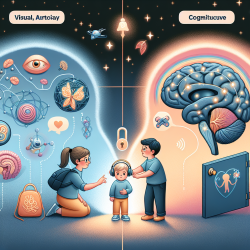Introduction
Sensorineural hearing loss (SNHL) is a prevalent congenital sensory deficit affecting children worldwide. Recent research has shed light on the brain's microstructural changes in children with SNHL, offering new avenues for therapeutic interventions. The study titled Cerebral volume and diffusion MRI changes in children with sensorineural hearing loss provides valuable insights into how MRI can be used to assess cerebral volume and diffusion changes, potentially guiding therapies to optimize language development.
Key Findings
The study conducted a retrospective analysis of 63 children with SNHL, comparing them to 64 age-matched controls. Key findings include:
- Higher median apparent diffusion coefficient (ADC) values in the cortex, thalamus, caudate, and brainstem of SNHL patients compared to controls.
- Smaller brainstem volumes in SNHL patients, irrespective of the severity of hearing loss.
- Greater amygdala volumes in children with unilateral SNHL compared to controls.
- Specific genetic mutations (Connexin 26 and Pendrin) associated with distinct diffusion changes in the brainstem and thalamus.
Implications for Practitioners
These findings underscore the importance of integrating MRI-based assessments into the therapeutic process for children with SNHL. By understanding the microstructural changes in the brain, practitioners can tailor interventions to better support language development. Here are some actionable steps:
- Incorporate MRI Assessments: Use MRI to monitor cerebral changes and adapt therapy plans accordingly, focusing on areas with altered diffusion metrics.
- Focus on Early Intervention: Early detection and intervention are crucial. Utilize MRI findings to inform decisions about cochlear implant candidacy and other interventions.
- Personalize Therapy: Consider the genetic etiology of hearing loss when designing therapy plans, as specific mutations may require different approaches.
- Collaborate with Multidisciplinary Teams: Work closely with radiologists and geneticists to interpret MRI data and refine therapeutic strategies.
Encouraging Further Research
While this study provides a robust foundation, further research is needed to explore the longitudinal impact of SNHL on brain development and the potential predictive role of MRI in therapy outcomes. Practitioners are encouraged to contribute to this growing body of research by:
- Participating in longitudinal studies that track brain changes over time in children with SNHL.
- Investigating the impact of various interventions on cerebral microstructure and language development.
- Exploring the role of MRI as a biomarker for predicting the success of cochlear implants and other therapies.
Conclusion
The integration of MRI insights into therapeutic practices for children with SNHL holds promise for improving language development outcomes. By leveraging data-driven approaches, practitioners can make informed decisions that enhance the efficacy of interventions, ultimately unlocking the full potential of children with hearing loss.
To read the original research paper, please follow this link: Cerebral volume and diffusion MRI changes in children with sensorineural hearing loss.










